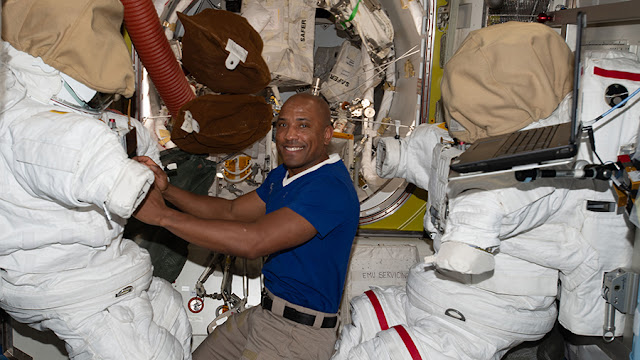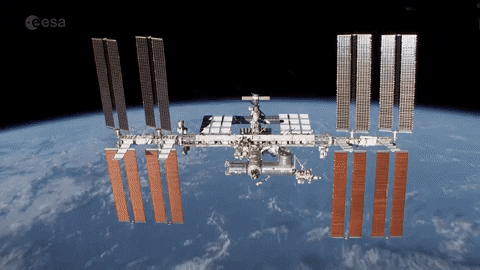ISS - Expedition 64 Mission patch.
Dec. 18, 2020
The Expedition 64 continued its human research studies today while also focusing on space manufacturing and technology investigations. Spacesuit maintenance has also wrapped up for the week aboard the International Space Station.
The lack of gravity in space is not the only factor affecting the human body. Solar radiation is also a concern as NASA plans crewed missions to the Moon, Mars and beyond. The station astronauts have been wearing the new AstroRad Vest this week testing for more than just radiation protection, but also comfort and fit. The vest design expands upon protective gear designed for emergency personnel responding to radiation exposure incidents on Earth.
Image above: Expedition 64 Flight Engineer Victor Glover works on U.S. spacesuits in the Quest airlock. Image Credit: NASA.
Muscle measurements and ultrasound scans were back on the schedule today for the long-running Myotones experiments. Blood samples are also taken to help doctors understand and treat muscle atrophy that occurs during spaceflight. Daily exercise offsets this loss, but insights from the investigation may provide alternate therapies for space crews, as well as more Earthbound muscle conditions.
Microgravity provides an ideal environment for producing high quality optic fibers superior to those created on Earth. Samples of optic fibers produced in the station’s Microgravity Science Glovebox were swapped out today for the ongoing Fiber Optic Production manufacturing study that may help commercialize space exploration.
Another study looking at optical communications today is testing the high-speed, high-capacity downlink of data from the orbiting lab. A unique, tiny pointing mechanism was installed for operations from Japan’s Kibo laboratory module for the SOLISS technology demonstration. The experiment uses lasers and could advance space communications and the transmission of data to and from remote locations on Earth.
International Space Station (ISS). Animation Credit: ESA
The crew cleaned up the U.S. Quest airlock today after a weeklong series of spacesuit maintenance tasks inside the spacewalk staging module. U.S. spacesuit components were upgraded, swapped and cleaned throughout the week as station managers begin planning spacewalks for 2021. Another spacesuit was packed inside the SpaceX Cargo Dragon resupply ship for return to Earth in January.
The new NanoRacks Bishop airlock, delivered Dec. 7 in the SpaceX Cargo Dragon’s unpressurized trunk, will be installed to the Tranquility module this weekend using the Canadarm2 robotic arm. Bishop will increase the capacity for commercial research, enable the release of larger satellites, and expand equipment transfers in and out of the station.
Related links:
Expedition 64: https://www.nasa.gov/mission_pages/station/expeditions/expedition64/index.html
AstroRad Vest: https://www.nasa.gov/mission_pages/station/research/experiments/explorer/Investigation.html?#id=7803
Myotones: https://www.nasa.gov/mission_pages/station/research/experiments/explorer/Investigation.html?#id=7573
Microgravity Science Glovebox: https://www.nasa.gov/mission_pages/station/research/experiments/explorer/Facility.html?#id=341
Fiber Optic Production: https://www.nasa.gov/mission_pages/station/research/experiments/explorer/Investigation.html?#id=7630
SOLISS: https://www.nasa.gov/mission_pages/station/research/experiments/explorer/Investigation.html?#id=7750
U.S. Quest airlock: https://www.nasa.gov/mission_pages/station/structure/elements/joint-quest-airlock
NanoRacks Bishop airlock: https://www.nasa.gov/directorates/spacetech/spinoff/New_Doorway_to_Space
Tranquility module: https://www.nasa.gov/mission_pages/station/structure/elements/tranquility/
Canadarm2 robotic arm: https://www.nasa.gov/mission_pages/station/structure/elements/mobile-servicing-system.html
Space Station Research and Technology: https://www.nasa.gov/mission_pages/station/research/overview.html
International Space Station (ISS): https://www.nasa.gov/mission_pages/station/main/index.html
Image (mentioned), Animation (mentioned), Text, Credits: NASA/Norah Moran.
Best regards, Orbiter.ch



